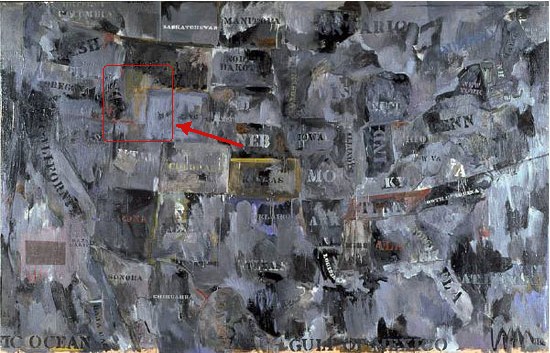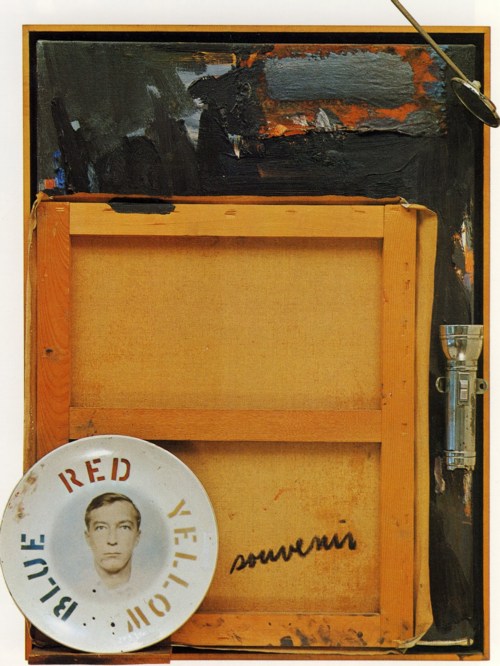
Barbara Rose called this partially obscured page of text "The most tantalizing fragment" visible in Jasper Johns' 1962 painting, Map, and speculated that it was "probably ripped from a paperback book Johns had in his studio." The visible word "rebel" resonated with Rose's idea that Map is akin to a battlefield map, and relates to the Civil War, the centennial of which was being commemorated when Johns, who had recently decamped for his native South Carolina, made the painting.

It turns out the page is from the short, 2-page preface to a hardcover, the 1960 US edition of Burgo Partridge's 1958 book, A History of Orgies. I bought this book, which is basically one Oxford student's quick tour through the dirty parts of the classics, followed by a brief history of sexual excesses and hypocritical moralizing in Europe, ending with a call to keep pushing modern society toward a Greek ideal of a sensible, guilt-free sexual culture.
A History of Orgies was apparently a good-, if not best-, seller, both in the UK and the US. After buying a copy online--strictly for research purposes, you understand--I skimmed through it. What I don't know about orgies could fill several books, but its argument, even its thesis, frankly, seems a bit scattershot. Perhaps more lucid syntheses of orgies have followed Partridge's? I'll wait for the orgiast literati to chime in. But it was impossible for me to read the preface without thinking of it in terms of Johns' work, and also his life in 1960-62, and the culture around him.
Rose calls the visible phrases "chosen and deliberately revealed," and says they "participate in Johns's game of peekaboo, which he plays with his audience, much as a stripper suggests that more will be revealed with each succeeding fan flutter," which is a kind of hilarious image, given the actual source of the text.
And just as the brushstrokes teasingly obscure some of the text, I also can't help wondering what's behind, what we can never see: the other side of the page. There are at least three Johns works from this period--Canvas (1956), Fool's House (1962), and Souvenir 2 (1964, below)--where the artist affixes smaller canvases face down on his larger work, depriving the viewer of knowing what lies underneath. I have no idea if there's anything in the first page of Partridge's preface that Johns wanted to not-show, but the full text of what he ended up not-showing is below.

Souvenir 2, 1964, which was in the Ganz collection until 1997 excellent discussion at Christie's
In the previous post, I referenced the skepticism, voiced by Yve-Alain Bois, of the usefulness of identifying [and thus being tempted to interpret] all the raw materials in Rauschenberg's combines. It's not like there's a unifying, hidden message, a Rauschenberg Code, waiting to be deciphered by some future Tom Hanks. But technology is rapidly making the once-impossible trivial, and art from the past is going to have to deal with it. It took me only a couple of Googling minutes to identify a text that Rose could only speculate on--and which Johns, if he ever meant for it to be identified, has certainly not discussed.
But this impact of instant, ubiquitous information reminds me of how Land Art, once intended to be remote and highly inaccessible, if not impossible to find, ends up on GPS systems and Google Maps. The times, they're a-changing.
Anyway, ladies and gentlemen, the preface to Burgo Partridge's A History of Orgies with pagination intact, and the texts visible in Johns' Map in italics:
[BEGIN QUOTE, P.7-8]
An orgy is an organized blowing-off of steam; the expulsion of hysteria accumulated by abstinence and restraint, and as such tends to be of an hysterical or cathartic nature.
Every kind of restraint produces its tensions. Man is in the awkward position of possessing both civilized and animal inclinations which have somehow to be reconciled, usually to the disadvantage of the latter, but increasing pressure cannot be withstood for ever, and so, from every kind of tension there is a release--the orgy. Many orgies would not be generally described as such. Wars are, in one sense, an extreme and disagreeable form, farther down the scale come quarrels at cocktail-parties, the practical jokes of stockbrokers, minor marital infidelities--one need not elaborate.
In this book orgies of a sexual character or origin only will be included; this, both because of their superior interest for everybody, and because of the difficulties of recognizing and defining some orgies of other kinds as such.
The orgy serves the useful purpose, not only of providing relief from tension caused by abstinence, necessary or unnecessary, but also rearousing by contrast an appetite for humdrum temperances which are an inevitable part of everyday life. Hence it has been used by such very different groups as the peoples of Ancient Greece, and (unwillingly), the medieval Christian Church.
There is, however, another kind of orgy, that of the individual. This is not, in fact essentially is not, organized or condoned by the state or by society, since it arises from the equation by the individual, of the society or state with the sense of confinement and restriction which afflicts him. This equation is often justified, on the other hand it is sometimes mistaken or inaccurately thought out.
These latter are perhaps the more interesting and less repetitive: the rebel is a more intriguing figure than the conformist, and in this particular field of study it is the latter who has received the greater attention. If one of them is treated at disproportionate length, it is hoped that the motives of the author will be understood.
Both kinds of orgy, the conformist and the rebel, can be reduced to the same principle--an escape from intolerable tension. One is likely to be successful, since it attacks the true root of the trouble, and if not accompanied by too-intense feelings of guilt and self-disgust will probably continue to function smoothly.
The other kind, that of the rebel, may also, providing the equation of oppression with society is correct, be satisfactory--but even so, the orgiast is likely to be a lonely and not altogether happy man--he will probably have over-reacted and have been driven to a degree of licence not indigenous to him.
The first two chapters deal with orgiasts of the conformist kind, but it was from one or other of these two very different patterns that subsequent 'rebels' tended to choose. Hence, it is important that the Greek and Roman natures should be born in mind, and the path for some attempt at ethical evaluation laid open.
[END QUOTE]
UPDATE Holy smokes, just flipping through the book tonight, I found this passage from the chapter on the Middle Ages and the Renaissance. In discussing a 14th century German outbreak of "choreomania," where church officials were condemning people would broke out into fits of provocative dancing of both immorality and heresy, Partridge writes:
This lumping together by an authoritarian body of all the heresies--religious, sexual, and political--the assumption that if a man is guilty of one, he must also be guilty of the others, is of particular interest when one thinks of the tendency of some Americans (and others) during the recent communist witch-hunts in the United States, to suggest that the political default of the offenders was, in some obscure way, connected with homosexual tendencies; and that a homosexual (quite apart from his liability to blackmail) is more liable to turn communist than a heterosexual, and is, accordingly, a greater 'security risk.' [pp101-2]Wow, in addition to being a concept torn straight [sic] from a Jonathan Katz paper on the Lavender Scare, that is one sentence.












